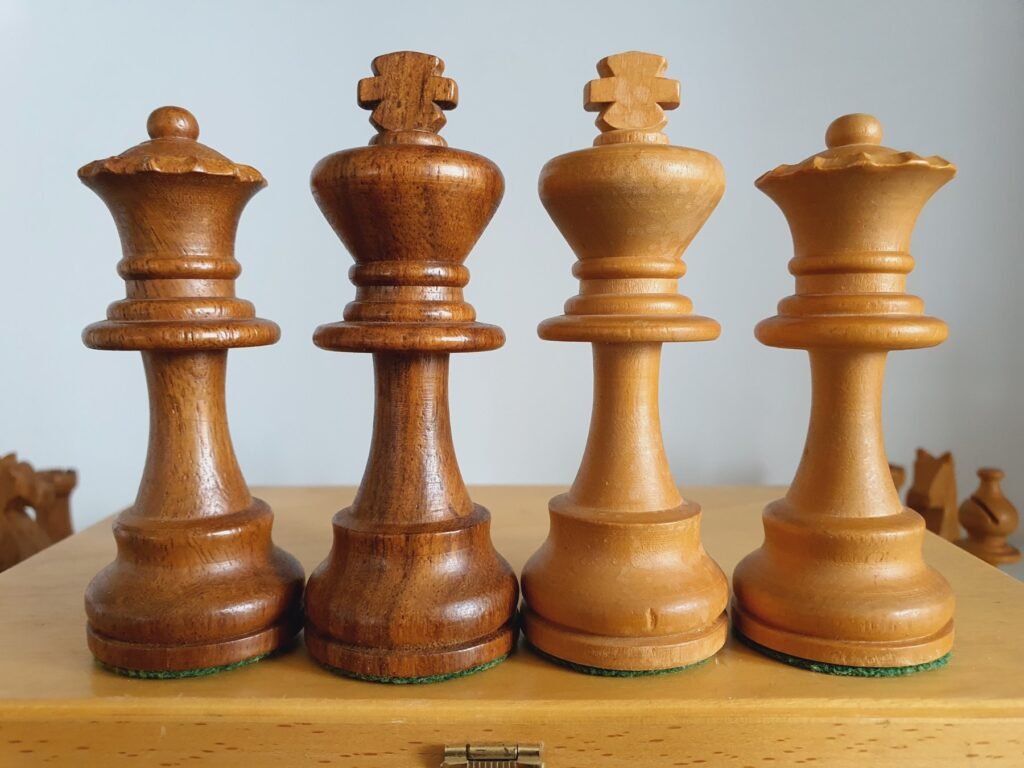The 1970’s-80’s German Knight chess set by “Unknown”.






Where did the German Knight come from?…
The German Knight—perhaps one of the most debated and polarizing chess designs in history. Its origins remain shrouded in mystery, sparking countless discussions in chess circles and online forums. Where did it come from? Who first conceived of this now-iconic design? Did it emerge from the skilled hands of German craftsmen, or was it influenced by other regions, like Spain or France? These questions have stirred passionate debate for years, with no definitive answers yet. Despite the vast amount of speculation, solid evidence about its exact origins continues to elude historians and collectors alike.
Some enthusiasts argue that the German Knight design is rooted in Germany, as its name suggests. Others trace its aesthetic lineage to Spain, pointing to similarities with some Spanish sets from the 19th century, while yet another camp believes it may have originated in France. This last group sees parallels between the German Knight and the French Chavet design, which has a similarly practical yet elegant structure. There’s also speculation that the design evolved from early 20th-century German sets that were prevalent during the rise of international chess competitions. These vintage German sets, with their simple yet functional pieces, could very well have influenced the streamlined design of the German Knight as we know it today.
However, as much as collectors and historians debate its origin, the truth is that the details of where or how the German Knight came to be have become less important over time. What truly matters now is that this design has been embraced and standardized across the chess world for its clean lines, ease of play, and universal appeal. The German Knight has become a staple in chess tournaments worldwide, from local clubs to international championships, because its simplicity in design does not detract from the focus of the game.
The real genius of the German Knight lies in its balance between form and function. Unlike more ornate or region-specific designs like the French Régence, Russian Imperial, or even the Barleycorn sets, the German Knight is stripped down to its essential elements, making it perfect for both casual play and high-level competition. The knight, with its minimalist, unembellished profile, has become synonymous with tournament play. There’s nothing extraneous—no unnecessary flourishes or complex carvings that could confuse the eye or hand. Its robust, no-nonsense design is incredibly playable, allowing for quick, intuitive movement during fast-paced games. Whether you’re playing blitz in a café or competing in a classical tournament, the German Knight simply works.
It’s precisely for this reason that the German Knight has carved out its own permanent place in the chess world. While other designs may be more visually striking or carry more historical prestige, the German Knight has, by virtue of its sheer practicality, been adopted as the go-to design in most international tournaments. Its pieces are universally recognizable and easy to handle, making it the preferred choice for chess federations around the globe. Whether you like it or not, this design has become a fixture in collections worldwide, often by default. For many players and collectors, owning a German Knight set is not a matter of personal preference—it’s a given, something that naturally finds its way into their homes simply because of its ubiquity in tournament play.








My opinion of this design…
For collectors like myself, the German Knight might not hold the same aesthetic or historical appeal as some of the more ornate sets in my collection, but it has a certain charm all its own. Its pieces are simple, yes, but there’s something satisfying in their solid feel, their well-balanced proportions, and their timeless functionality. It’s the kind of set you pull out when you want to focus purely on the game without distraction—no fuss, no frills, just pure chess.
In the end, whether you’re a player or a collector, the German Knight design is one that deserves respect. It’s not about its historical mystery or its debated origins. It’s about its place in the modern chess world, its role as the go-to set for serious players, and its ability to stand the test of time. It may not be the most glamorous or unique set in my collection, but its importance cannot be understated. The German Knight has earned its spot on the chessboard, and whether we realize it or not, it’s become a part of every serious player’s or collector’s life.
So, here it is—one of mine. Whether it’s vintage or modern, antique or reproduction, the German Knight is a set that belongs in any serious collection, offering both a link to chess history and a perfectly practical design for the modern game.








